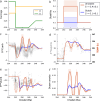Earth system instability amplified biogeochemical oscillations following the end-Permian mass extinction
- PMID: 40251165
- PMCID: PMC12008425
- DOI: 10.1038/s41467-025-59038-0
Earth system instability amplified biogeochemical oscillations following the end-Permian mass extinction
Abstract
After the end-Permian mass extinction, the Earth system underwent extreme ecological and environmental fluctuations, including high temperatures, recurrent oceanic anoxia, and carbon cycle oscillations as demonstrated by the geochemical isotope proxy records. However, the underlying mechanism behind these oscillations remains poorly understood. Here we propose that they were produced by a coupled oscillation mode of marine phosphorus (P) and atmosphere-ocean carbon (A), driven by nonlinear redox controls on marine phosphorus burial. Our modeling demonstrates that the initial emplacement of the Siberian Traps and the mass extinction (on land and in the ocean) directly led to an early Triassic greenhouse. More importantly, it homogenized the ocean floor redox condition towards anoxia, activating amplifying feedbacks and destabilizing the system. The internal dynamics of an unstable system-rather than recurrent volcanic shocks-triggered the periodic oscillations (limit cycles) of serial excursions in carbonate carbon and uranium isotopes during the early Triassic.
© 2025. The Author(s).
Conflict of interest statement
Competing interests: The authors declare no competing interests.
Figures





Similar articles
-
Massive and rapid predominantly volcanic CO2 emission during the end-Permian mass extinction.Proc Natl Acad Sci U S A. 2021 Sep 14;118(37):e2014701118. doi: 10.1073/pnas.2014701118. Proc Natl Acad Sci U S A. 2021. PMID: 34493684 Free PMC article.
-
Marine anoxia and delayed Earth system recovery after the end-Permian extinction.Proc Natl Acad Sci U S A. 2016 Mar 1;113(9):2360-5. doi: 10.1073/pnas.1515080113. Epub 2016 Feb 16. Proc Natl Acad Sci U S A. 2016. PMID: 26884155 Free PMC article.
-
Volcanic CO2 degassing postdates thermogenic carbon emission during the end-Permian mass extinction.Sci Adv. 2023 Feb 15;9(7):eabq4082. doi: 10.1126/sciadv.abq4082. Epub 2023 Feb 15. Sci Adv. 2023. PMID: 36791190 Free PMC article.
-
The great catastrophe: causes of the Permo-Triassic marine mass extinction.Natl Sci Rev. 2023 Oct 25;11(1):nwad273. doi: 10.1093/nsr/nwad273. eCollection 2024 Jan. Natl Sci Rev. 2023. PMID: 38156041 Free PMC article. Review.
-
Eutrophication, microbial-sulfate reduction and mass extinctions.Commun Integr Biol. 2015 Dec 4;9(1):e1115162. doi: 10.1080/19420889.2015.1115162. eCollection 2016 Jan-Feb. Commun Integr Biol. 2015. PMID: 27066181 Free PMC article. Review.
References
-
- Chen, Z. Q. & Benton, M. J. The timing and pattern of biotic recovery following the end-Permian mass extinction. Nat. Geosci.5, 375–383 (2012).
-
- Fan, J. X. et al. Triassic marine invertebrate biodiversity. Science367, 272–277 (2020). - PubMed
-
- Xu, Z. et al. End Permian to middle Triassic plant species richness and abundance patterns in South China: coevolution of plants and the environment through the Permian–Triassic transition. Earth-Sci. Rev.232, 104136 (2022).
-
- Payne, J. L. et al. Large perturbations of the carbon cycle during recovery from the end-Permian extinction. Science305, 506–509 (2004). - PubMed
Grants and funding
- 41930322/National Science Foundation of China | National Natural Science Foundation of China-Yunnan Joint Fund (NSFC-Yunnan Joint Fund)
- 202106410094/China Scholarship Council (CSC)
- NE/T008458/1/RCUK | Natural Environment Research Council (NERC)
- NE/T008458/1/RCUK | Natural Environment Research Council (NERC)
LinkOut - more resources
Full Text Sources

